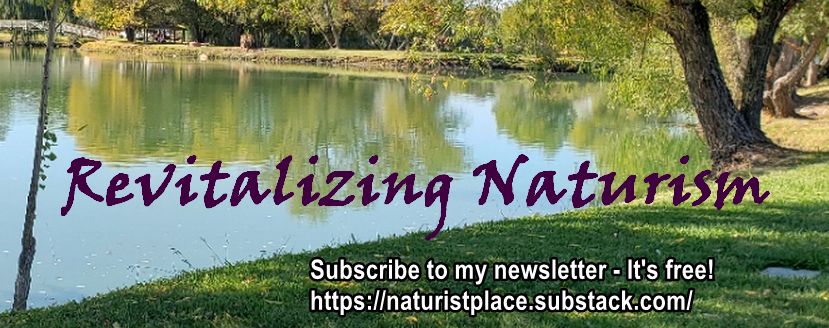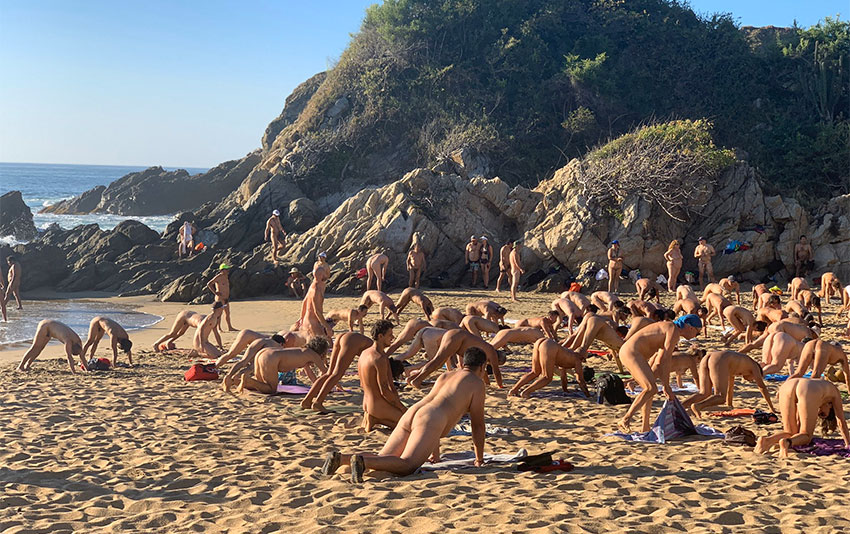
- Dining unclad de rigeur at Zipolite’s annual nudist festival
Although there are some food-related stories below, this isn’t really one of them. Zipolite is a popular clothing-optional beach in Mexico on the Pacific Ocean coast south of Mexico City. This is the fifth year of an annual and very popular naturist festival on the beach. This year’s attendance was about 6000. The beach has had clothing-optional use since at least the 1950s, but has only recently become much better known outside the local area.Since many attendees spend much of their time on the beach, they often eat there too – but that’s only in addition to a variety of other common beach activities. For instance, volleyball, body painting, musical performances, yoga, or simply sunbathing. Since the beach is only about 15° north of the Equator, temperatures in January-February are quite comfortable – in the 80s (F).
More: Everything You Need to Know before Visiting the Zipolite Nudist Festival 2020, The Zipolite Nudist Festival 2020: Our Experience
- Florida bill would make it legal to be naked at a nude beach
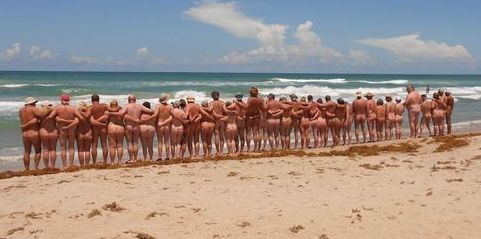
Under section 800.03 of Florida’s legal code “exposure of sexual organs” is illegal in public or if visible from someone else’s property if it’s done in a “vulgar or indecent manner”. It’s also illegal simply to be “naked” in public “except in any place provided or set apart for that purpose”. However, both of these provisions are somewhat vague, especially in case of simply being naked on a beach that’s traditionally “clothing-optional”. And what about exposure of female breasts?In particular, there are several beaches in Florida that have long been popular with naturists, including Haulover Beach in Miami, and portions of Apollo and Playalinda beaches in the Canaveral National Seashore. And a new clothing-optional beach has just been approved near Fort Pierce (as noted here). It’s not entirely clear that those locations have officially been “set apart for that purpose”. This new legislation would take care of the ambiguities – if it becomes law, which isn’t a foregone conclusion. The bill would expressly allow being “naked in public … including, but not limited to, clothing-optional beaches.”
The bill could well become law, since Florida is slowly waking up to the benefits to its tourist industry of people interested in clothing-optional recreation. Given the prevalence of many naturist resorts around the state, local tourist bureaus may want to attract naturists to their own clothing-optional places. (The article is also here.)
- Nude beach quietly routine at Volusia’s southern tip
The beach in question is the aforementioned Apollo Beach in the Canaveral National Seashore. (There’s an unincorporated place of the same name on the opposite side of the state, which should not be confused with the actual beach.) Clothing-optional use is traditional only in the southern portion, adjacent to parking lot #5. Unfortunately, the parking lot has only 35 parking places, and it fills up early on any day with decent weather. (There’s sometimes a similar problem with parking lot #13 at Playalinda Beach, adjacent to the clothing-optional section.)The small parking lot is a problem, since it’s a 2-mile hike to the next parking lot to the north – especially if you need to carry much, like beach chairs or a cooler. Of course, if you’re not alone, you can drop companions and gear off, then go back to park. Still it’s a hassle, especially since the lagoon on the side of the road opposite the ocean is quaintly named Mosquito Lagoon, and appropriately so. Fortunately, the beach itself at lot #5 is not only clothing-optional but also less popular with the mosquitoes.
According to the article, regulars at the clothing-optional part of Apollo Beach are a fairly laid-back bunch. They’re not all naturists, but they have relaxed attitudes towards nudity, and are generally content to share the beach with others, whether or not they’re naked. One beach regular, who doesn’t get naked, was quoted remarking “Some people get naked, other people don’t, and everyone gets along.” If only the same level of tolerance prevailed in many other places…
- Top 10 U.S. Nude Beaches
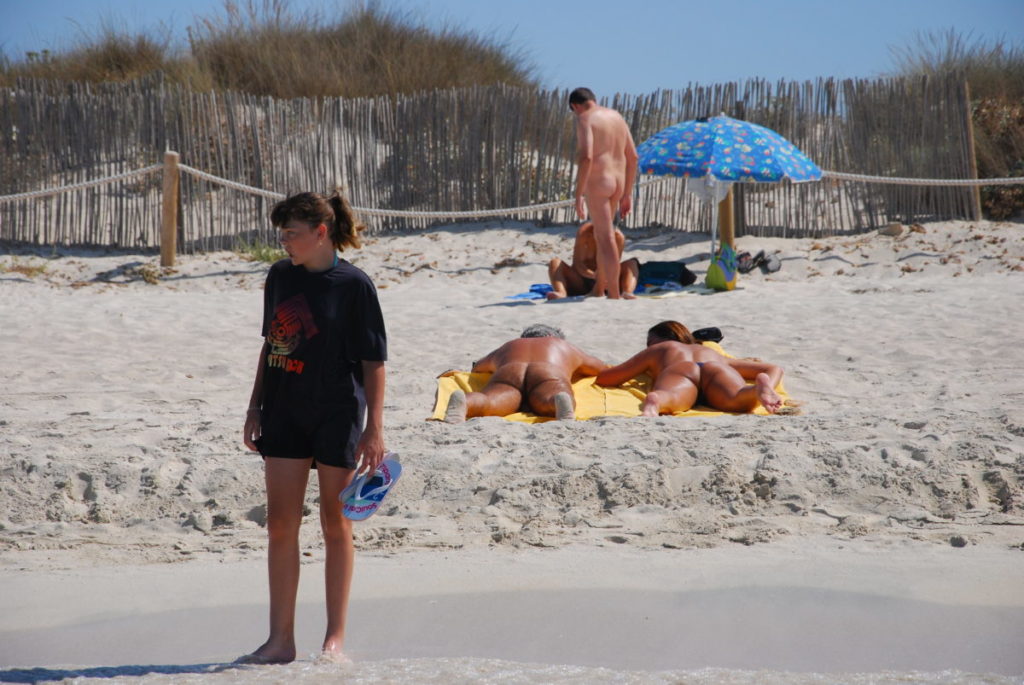
Articles like this appear periodically in widespread sources (at least in the western half of the world). Usually these are found in media having a general readership. But this one is on a naturist resort’s website – DeAnza Springs in southern California. Even so, all places mentioned are actual beaches, not resorts, and are open for public use (with at most small charges for parking). Another list, which includes 5 U. S. beaches and 5 in other countries, was discussed here. (The 5 U. S. beaches are also in the present article.)Some of the beaches mentioned, such as Haulover, are frequently included in lists of best clothing-optional beaches worldwide, but others probably wouldn’t qualify. The actual criteria for inclusion of beaches here aren’t stated. Perhaps it’s mainly popularity, which would be related to convenience of access (certainly one important criterion). However, Black’s Beach is notoriously difficult to reach, as it requires steep climbs down and up tall cliffs just behind the beach. The reviews would have been better if they’d included more information on the convenience factor – things like distance from population centers, physical ease of access, typical climate, etc. Instead, there’s often more about the history of the beach, which isn’t necessarily useful for potential visitors.
In one case (“San Gregorio Private Beach”) the information given is confusing. San Gregorio State Beach is part of the State Park system, and as such is not clothing-optional. But there’s an excellent large beach adjacent to the north that is clothing-optional. It’s “private” in the sense that the parking area is on private land and not always open. The beach description, however, clearly describes the State Park beach. What a shame the description here isn’t better. The history of San Gregorio is actually relevant, since it’s regarded as the oldest established clothing-optional beach in the U. S. The location of the beach isn’t fortuitous, because it was selected in 1966 by a few young people from San Francisco’s nascent hippie culture as the most suitable beach for skinnydipping after scouting many locations not too far from the city.
- Public speaker and The English Cream Tea Company boss Jane Malyon gives a talk at a Bournemouth hotel to 180 naturists

The article is an account by the speaker, Jane Malyon, about the talk she gave in January to a naturist group (which wasn’t named) that was spending the weekend at a hotel (also not named) in Bournemouth (UK). What’s interesting about this article is how it treats as something quite normal a talk given by a public speaker to a large group of naturists. Jane was fully informed beforehand to expect the audience to be completely naked, and evidently she wasn’t fazed at all by the prospect. Not even, according to her report, when “immediately upon entering the hotel, I was surrounded by lovely, smiling, friendly people, all of whom were totally stark naked.”To some extent, her reaction wasn’t too surprising. Jane describes herself as “a professional speaker and author, and an expert on the history and etiquette of afternoon teas, appearing regularly on TV and radio.” She’s also a managing director of a company in the UK “afternoon tea” business. So she’s paid to do these talks promoting somewhat of a niche industry. Why, after all, pass up another good opportunity to talk about something she loves merely because the audience comprises “people who have no clothes on. Absolutely nothing.” She was even “advised that my own clothing would be optional.” Evidently she didn’t immediately dismiss the idea, but eventually declined based on advice from her agent, on the basis that there would be a photographer.
The balance of the article has only laudatory things to say about the naturist audience and the overall experience. She “didn’t find the nakedness in front of me particularly off-putting, though perhaps a little surreal.” However, she does observe that “the majority of attendees at this event were middle-aged or older.” Still, one has to wonder whether her invitation to speak might have perhaps been less likely if the group were mainly younger and less interested in the “afternoon tea” business.
- The Joy of Cooking Naked

On one hand, it’s generally a positive thing when naturism gets attention from such a thoroughly mainstream organ as the New York Times. Articles like this can help by exploding prevalent misunderstandings about naturism, such as the notion that it’s all about sex or swinging. On the other hand, in the process of doing that articles haul out trite bromides such as “don’t cook bacon while you’re naked”. So while dissing some common clichés they fall back on promoting others. Give it up, eh? Naturism can really be understood only by trying it, not just reading about it. Sort of an acquired taste, you might say (if you want to play on the culinary metaphor). Keep that in mind when discussing naturism with your friends.The subtext in this article is that naturism has some “special” relationship with cooking and eating. Actually, what’s probably going on is that the writer had to stress the food connection so the article could enliven the Times’s food section. The truth, of course, is that not only cooking and eating but almost anything that people take pleasure in can also be enjoyed naked. And besides, you might get naked to use a swimming pool or spa, and then get dressed afterward. If you’re not usually naked at home, there’d be little reason to get naked for cooking and eating. But if you are usually naked, you’d probably stay naked at mealtimes. Still, there is a connection, tenuous though it may be, between naturism and food, because some early forms of naturism also embraced vegetarianism. But that’s not much of a thread to hang a story on. Vegetarianism is certainly a valid choice, but these days the preferences of naturists with respect to food are as varied as among most other types of people.
The naturist element of the article focuses on life in Florida’s Lake Como Family Nudist Resort. Presenting the stories of various long-time habitué’s there – often in their own words – allows for highlighting some of the unique aspects of naturist lifestyles. In particular, sharing meals together informally or having more orchestrated dinner parties has always been especially popular with naturists – because it’s a natural justification for getting together naked with others. Just about everyone likes to eat, whereas not everyone cares a lot for board games, dancing, jigsaw puzzles, or what-have-you. Sharing food together is as old as humans and even their ancestral species. Those prehistoric folks were probably naked, too, as least in the warmer climes.
Having decent restaurants is a must for upscale naturist clubs and resorts. More recently there have been attempts to start clothing-optional restaurants as a business. One-off events of that type often sell out long in advance. Unfortunately, however, such things have had rather little commercial success. Even the mainstream restaurant business is very hard to break into. With a much smaller potential customer base, business is even harder for naturist restaurants. That’s not necessarily such a bad thing for naturists, though. Socializing in a familiar, comfortable space with others who share an unorthodox lifestyle – is bound to be more satisfying than what’s possible in restaurants full of strangers.
- Inside the World of Nudist Cooking

This is basically a concise summary of the New York Times article above. But it makes the most important points much more succinctly:
“There are millions of nudists in America, and because they are people, they do many of the same things other people do — they just do them naked. As revealed in a recent New York Times feature detailing the lives of the naked residents of the Lake Como Family Nudist Resort in Lutz, Florida, this roster of otherwise normal tasks and activities nudists happen to perform naked includes cooking, because why wouldn’t it?” - Food in the nude: Switzerland to get its first naked restaurant
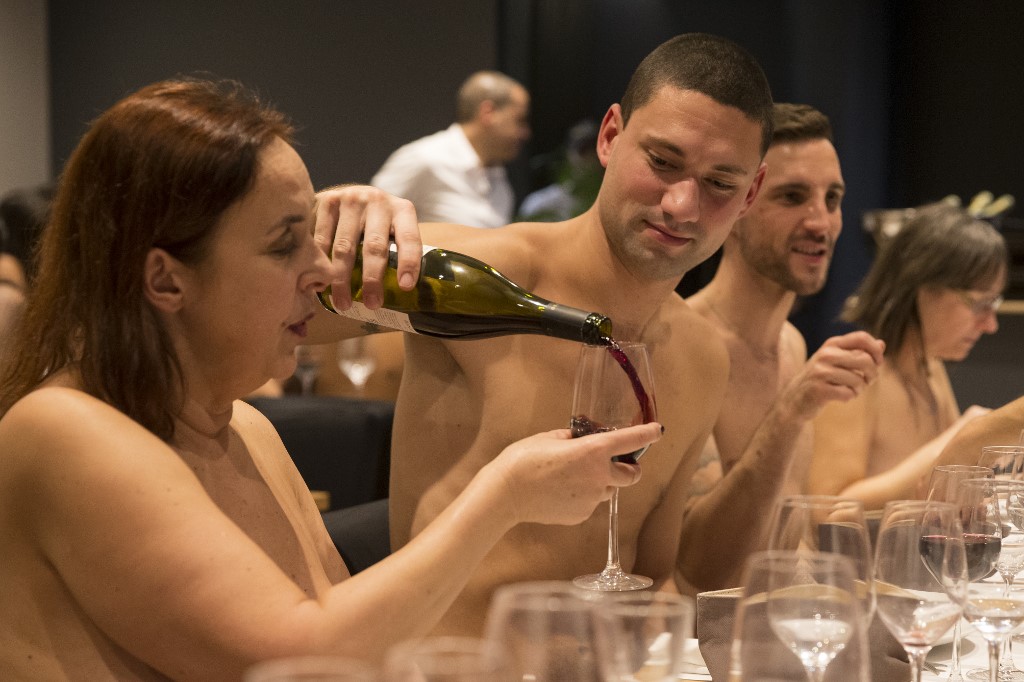
Despite the immense difficulties of making a restaurant for naturists into a sustainable business, hope (seemingly) springs eternal. According to reported plans, the establishment will be called “Edelweiss Basel – Nudisten Lounge” and will open at the end of February. Patrons will be able to leave their clothes in a cloakroom, although anyone not brave enough to be naked can keep their underwear on. (Ewwwww. Seriously?) And waiters will be naked. If this isn’t somebody’s idea of a joke, we can certainly hope this one does better than the O’Naturel in Paris. Switzerland isn’t exactly noted as a popular place for naturism – although naked performance art has been done publicly in the streets of Zurich. - Look Ma! No Hands!

Fred is a southern California naturist who enjoys a wide spectrum of naturist activities – most of which aren’t confined to private naturists resorts. The annual “Bare to Breakers” run in San Francisco in May is one of his favorites. He has a whole post about it here. But that’s not all. Mainly he simply enjoys nudity, either alone or with others:
“I just enjoy being nude. Period. Don’t need an excuse for it. Have no interest in rationalizing it. I enjoy it alone. I enjoy it socially. I enjoy it if I’m the only one nude and I enjoy it just as much if everyone is nude. I enjoy it up on a stage doing improv in front of a hundred complete strangers or in a living room with a couple of friends or alone on the trail miles from anywhere.”He notes that “nude public events have become much more common.” “Bare to Breakers” is just the informal name used by naturists who run or walk naked in the official Bay to Breakers event. But there are a number of similar examples where public nudity is allowed, some also in San Francisco. Additionally, there are also World Naked Bike Rides in many cities around the world, Seattle’s Fremont Solstice Parade, Spencer Tunick “installations”, political protests of many sorts, body painting events, public naked performance art events, and occasional naked museum tours (see below).
A more novel type of event with public nudity is do-it-yourself theatrical projects as part of the Hollywood Fringe Festival, which can involve nudity and which Fred is planning to do, as he describes here, here, and here. Another Fringe Festival event with plentiful nudity was a production of the play DISROBED, which was reported on here.
Fred also enjoys nude hiking, and his blog contains a number of reports of these treks. He summarizes his naturist interests thusly:
“As far as nudie activities go, I prefer to get off the reservation. Resorts can easily turn into expanded closets. They can become well-appointed ghettoes if you let them. Trips to hot springs, hiking in the wild, camping in remote places, parties, public events, that’s where I’ll find my space. I am not a big fan of highly regulated environments.” - Australian museum opens its doors to an exhibition aimed at nudists
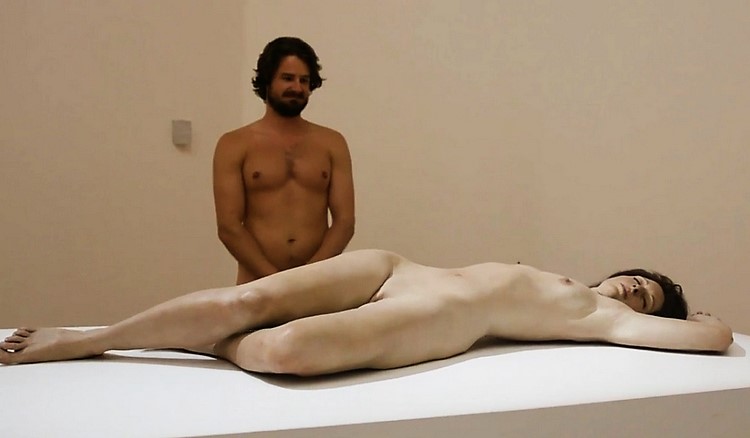
This article appeared on the Brazilian Os Naturistas site (without a link to the original), so it’s in Portuguese. But translations into other languages are available by selecting the flag of the country whose language is closest to yours.Although the linked article is recent, it apparently describes an event in January 2018 at the National Gallery of Australia. A better, contemporary account is here. 120 people who wished to be naked for the tour got tickets to attend. According to the article “The event was held around his hyper-realistic exhibition exploring the human figure through a series of sculptures and paintings.” So much of the artwork on display involved nudity. Some of it was so “hyper-realistic” – as in the picture – that it’s difficult to distinguish the attendees from the art. There’s a video at the link that conveys the best impression of the event, even though the nudity of the attendees (but not the art) was censored.
The National Gallery has had naked events before, for example a 2015 event described here, here, here, here, here. and here.
- Japan’s naked art of body positivity
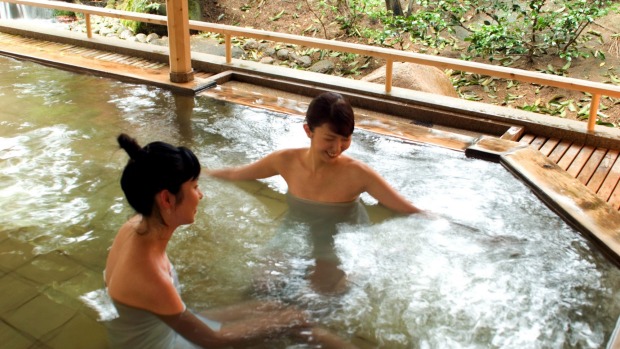
For almost all practical purposes, naturism doesn’t exist in Asia (except for Thailand). In Japan, however, there is a bizarre kind of pseudo-naturism. That is, full nudity – but only (for the most part) in rigidly gender-segregated facilities. The Asian mind is, as usual, inscrutable to westerners.Naturists may not be especially excited about Japan as a travel destination, but it’s at least worth noting a couple of things. First, there are two types of public bathing facilities where nudity is required. There are the well-known onsens, which are natural hot springs. Since these are located near volcanically active areas, they’re usually far from urban centers. There’s also another type of public bathing facility known as a sento. Since these heat water from the local water system, they may be found almost anywhere. Second, since onsens are mostly in unurbanized areas, they provide a much more “natural” experience and are a bit more likely not to require gender segregation. In either case, however, note that Japan, being what it is, has many unbreakable customs and rules which must be observed. In addition to many rules of proper etiquette for using any bathing facility, there are other “gotchas”, such as a strong Japanese prejudice against tattoos anywhere on the body.
